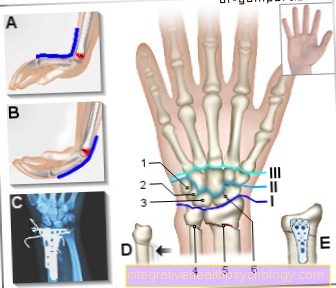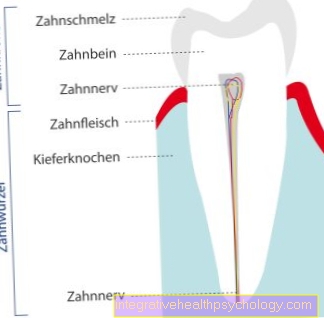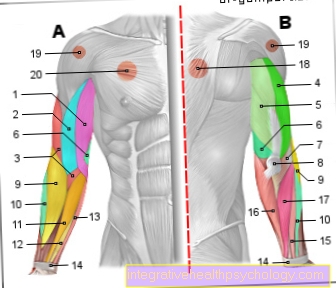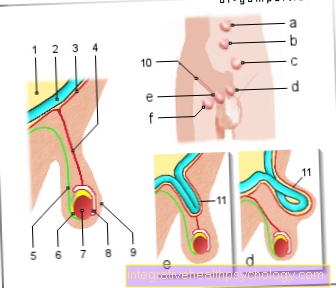Causes of an intestinal obstruction
introduction
With an intestinal obstruction (Ileus) it is a disturbance of the intestinal passage through a narrowing or strangulation. As a result, the intestinal contents can no longer be transported further towards the anus and excreted, which leads to stool congestion and the typical symptoms of ileus, such as severe abdominal pain, vomiting, flatulence and constipation.
Both the small intestine and the large intestine can be affected by an intestinal obstruction. In general, an intestinal obstruction is an acutely life-threatening situation that must be treated in the hospital as quickly as possible, as otherwise parts of the intestine can die.

Overview of the causes
The causes of an intestinal obstruction are diverse. Basically you have to differentiate between:
- more functional (paralytic) Intestinal obstruction
- mechanical intestinal obstruction
The two types of ileus each have different causes.
- The mechanical ileus is triggered by a clamping of the bowel or an obstacle that prevents further bowel passage.
- In contrast, the functional ileus has no mechanical but a functional cause. This means that the forward movements, the so-called intestinal peristalsis, come to a standstill and the intestinal contents are not transported further. The intestinal muscles no longer contract and the intestine is paralyzed.
Functional causes would be e.g. the insufficient supply of blood to a section of the intestine due to a vascular obstruction. A functional ileus can also be caused by the administration of various drugs, surgical interventions or injuries.
In addition to mechanical and functional intestinal obstruction, there is a third form, the mixed ileus. It is a combination of the two types, which often represents the transition from mechanical intestinal obstruction to intestinal paralysis, i.e. paralytic intestinal obstruction.
Causes of a mechanical ileus
A mechanical bowel obstruction can arise in different ways. A distinction is made between strangulation, obstruction and gallstone ileus among the causes. In many cases, the mechanical ileus is the result of so-called strangulation, in which a section of the intestine is tied off. This happens either through adhesions that lead to an intestinal kink, or through internal and external hernias (intestinal hernias) that clamp off the affected section of the intestine. Due to the strangulation, the intestinal wall can no longer be adequately supplied with blood. As a result of the circulatory disorders, parts of the intestine irreversibly die, which is why an intestinal obstruction must be treated as an absolute emergency.
A mechanical intestinal obstruction can also occur without accompanying circulatory disorders; one then speaks of a so-called obstruction. The inside of the intestine (intestinal lumen) is blocked by a foreign body, e.g. swallowed objects, tufts of hair or excrement stones, blocked. An obstruction can also occur due to a strongly thickened intestinal wall in the context of inflammation or tumors.
In a gallstone ileus, a gallstone enters the intestinal tract from the gallbladder, where it obstructs the intestinal passage. The stone enters the intestine via a non-naturally existing connecting duct between the bile duct and the small intestine, a so-called cholecysto-duodenal fistula.
tumor
Tumors that grow in the abdomen and pelvis can cause an intestinal obstruction. Usually it is a mechanical closure of the colon. Especially tumors that originate from the fallopian tubes or the peritoneum ormetastasized there can put a lot of pressure on the colon and compress it. The tumor can also grow into the intestinal wall and thereby narrow the intestinal lumen even further. As a result, the intestine is clamped and the intestinal passage is obstructed.
Adhesions
Adhesions are the most common causes of mechanical ileus. The connective tissue adhesions often form in the area of the mesenteric tissue, the vascular fatty tissue around the intestine. The adhesions, which are also called Briden, cause the intestinal loops to connect to the peritoneum, which sometimes causes severe pain. Abdominal surgery in particular promotes the creation of the clamps. A loop of the small intestine can be pinched so tightly within the adhesions that the intestinal peristalsis comes to a complete standstill and an intestinal obstruction occurs.
Read more about this under: Adhesions in the abdomen
Crohn's disease
Bowel disease, Crohn's disease, can be another cause of bowel obstruction. This is an autoimmune disease that causes chronic inflammation of the intestinal lining. The constant inflammation and the subsequent healing of the lesions form scars that can lead to the formation of an ileus. The scarring of the intestinal mucosa can thicken the intestinal wall and narrow the intestinal lumen. As a result, the intestinal contents can no longer properly pass through the intestine and an intestinal obstruction forms.
Bowel twist / strangulation / hernia
A common cause of mechanical bowel obstruction is so-called strangulation. In the case of strangulation, in addition to clamping off an intestinal loop, the blood supply to the affected section of the intestinal wall is also interrupted. Strangulations are caused by twisted intestines (volvulus) or hernias (hernias). A volvulus occurs when the bowel rotates around itself and devours itself, causing a pinch-off. In a hernia, the intestines are forced through a gap in the abdominal wall. In unfavorable cases, the hernial sac contains a complete intestinal loop, the contents of which can then no longer be transported.
Diverticulitis
Intestinal obstruction can result from diverticulitis, especially in older patients. Diverticula are protrusions of the intestinal wall that can become inflamed (Diverticulitis). Frequently recurring inflammation of the diverticula and the associated scarring of the intestinal mucosa favor the development of an intestinal obstruction. It mainly affects the large intestine.
Causes functional intestinal obstruction
A paralytic ileus is caused by a functional disorder of the bowel and is also known as bowel paralysis. This means that the intestine is continuous and not interrupted by a mechanical obstacle. A further distinction is made between a primary and a secondary paralytic bowel obstruction.
The reason for a primary functional ileus is an occlusion of the vessels that supply the small intestine or the large intestine. Vascular occlusion can be caused by vascular thrombosis (a blood clot forms in the vessel) or embolism (the vessel is blocked by material that has washed in, e.g. a plug of fat). The blockage interrupts the blood flow and the intestinal muscles are no longer adequately supplied with oxygen and nutrients. As a result, the intestinal wall loses tension and can no longer transport the intestinal contents. In rare cases, the blood supply can also be interrupted by a large hematoma or tumor that is compressing the vessels.
A secondary paralytic ileus can reflexively occur after operations (especially Laparotomies), blunt injuries or inflammation (such as in the context of peritonitis or blood poisoning) occur in the abdomen. Certain medications, such as opiates or certain antidepressants, can also cause a functional intestinal obstruction. In addition, a mechanical ileus in the terminal stage always changes into a paralytic ileus. The reason for this is the massive release of toxins, which are produced by the uncontrolled reproduction of bacteria in the stagnant intestinal contents.
Causes in the baby
A common cause of intestinal obstruction in babies and young children is invagination. A section of the intestine turns into the part behind it. As a result, the intestinal contents build up and a mechanical intestinal obstruction forms. The invagination of the intestine is moved back again as part of an operation.
Read more on the subject at: Recognize intestinal obstruction in babies





























